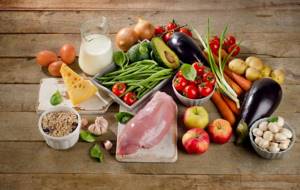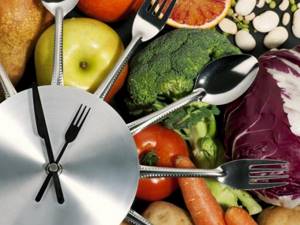Modern food cannot be fully considered healthy and at the same time nutritious for the body. Many food manufacturers, in an attempt to save money, add low-quality ingredients to their products, which, if consumed for a long time, have a negative impact on health.
First of all, this is reflected in the figure, because not everyone can regularly visit the gym or engage in physical activity. But excess weight is not only the consequences of overeating or eating low-quality, fatty foods. A sedentary lifestyle, negative habits, stress - all this can contribute to the gain of extra pounds. And obesity has never contributed to the respect of others. They give admiring glances to a beautiful and slender body.
It's not just about attractive appearance; extra pounds, in addition to all the inconveniences, cause great harm to the body. After all, an unprepared skeleton has to withstand additional load, and first of all it falls on the joints.
Positive aspects of fractional nutrition
The portioned diet regimen has quite a lot of fans, not only because it helps to quickly and reliably lose excess weight, but due to its positive effect on the body and human health. Eating small meals frequently helps normalize metabolism and even prevent the development of certain diseases.
Other advantages of fractional meals include:
- improving the absorption of nutrients by the body;
- normalization of blood sugar levels;
- preventing the development of ulcers, gastritis and other stomach diseases;
- normalization of the processes of formation of fatty deposits.
In addition, a fractional diet is quite easy to adhere to, since it does not cause psychological and physical discomfort. The daily diet menu includes various products from which you can prepare very tasty and healthy dishes, eliminating hunger and the desire to snack on something harmful. However, it is important to distribute calories evenly across portions. Thus, the body does not strive to receive harmful, fatty foods, because it knows that it will receive a new portion in a few hours and does not put aside reserve reserves, since with a balanced diet there is no stress, unlike hunger strikes and strict diets.
Its effect on the body
The technique helps to get rid of extra pounds and significantly reduces body fat. Thanks to small portions, the stomach becomes much smaller.
The person no longer feels a strong appetite and does not overeat. Frequent doses normalize metabolism and relieve abdominal discomfort and bloating.
The menu includes a lot of fruits and vegetables. They fill the body with vitamins and increase immunity. Such nutrition heals the entire body and improves well-being.
Fractional power system options
Before you decide to switch to fractional meals, you need to know that there are various options for such a system with a general principle, but distinctive features of food intake. It is necessary to choose one or another type of dietary system taking into account your own lifestyle, employment, health status and preferences.
The most common types of fractional meals today include:
- meals every 2-3 hours;
- dividing nutrition into 5-6 meals a day;
- food upon request.
Please note: You can choose the fractional diet regimen that suits you best, because not everyone can follow strict rules and eat every 2 hours.
In this case, focusing on your rhythm of life, you can choose the most effective and comfortable type of nutrition, which will help you achieve good results. However, before making a choice, it is necessary to consider each type of fractional system, its features, rules and privileges.
Option 1: Eat every 2 or 3 hours
The standard and most common option for fractional meals is eating strictly according to the hour. In such a case, food divided into portions must be taken every 2-3 hours. What are the benefits of such a fractional regime? Firstly, stress for the body is completely eliminated, since, once you get used to receiving food after a strictly defined period of time, the diet goes quite easily and without complications. In addition, a fractional regimen of this type also allows you to preserve and build muscle mass, which is why it is often used by professional athletes.
This type of dietary fractional system has some differences from the traditional nutrition option:
- the daily menu is divided into 8-10 meals in limited quantities;
- the number of calories per day should be evenly divided between all meals;
- the volume of food at one time is reduced to the amount of one glass;
- eating should be alternated strictly every 2-3 hours;
- The optimal amount of water per day is 1.5-2 liters.
This option of healthy fractional nutrition has many advantages. Despite the limited portion size, you will not feel hungry at all, since meals are repeated quite often.
Option 2: Eat every 5-6 hours
A fractional diet for weight loss according to a 5-6 hour scheme is the second most popular and effective option for a healthy and wholesome diet. In this case, the menu compiled for the day is divided equally into 5 meals, which are consumed every 5 or 6 hours. This version of the fractional mode is more practical and suitable for any rhythm of life. Portions are divided equally for each meal, but may consist of different types of products and recipes.
Important! To achieve a positive result in the fight against excess weight using the fractional system, it is necessary that the number of calories consumed per meal be equal. An uneven amount of calories will not give the body the opportunity to get used to this way of eating and will contribute to the deposition of fat reserves.
The fractional system option, based on eating every 5-6 hours, is less effective compared to eating every 2-3 hours, but it is more convenient, since not everyone has the opportunity to eat so often, especially on weekdays.
Option 3: We eat when we want
The ad libitum diet is the least effective of the three split diet options. It's no secret that the desire to eat whenever we want and losing weight are incompatible things. And, nevertheless, this type of fractional system with some restrictions and rules can also help you lose a few extra pounds. In a fractional system, this type of nutrition means that you can eat whenever you feel hungry. This could be a meal every 15, 30, 60 minutes, however, it should be a feeling of physical hunger, and not a desire to eat something tasty. For example, you can create a menu of separate fractional meals, according to which you are allowed, in addition to several main meals, to eat an apple, orange, cracker or other healthy and low-calorie foods when you are hungry. However, it is necessary to understand that such a chaotic rhythm can often bring health problems rather than weight loss.
The “roller coaster” mode has the following negative consequences for the body:
- indigestion;
- difficulties in creating a healthy and balanced menu for weight loss;
- overload of the digestive system, which complicates the absorption of nutrients;
- risk of overeating;
- loss of rationality in determining the feeling of hunger.
With this type of diet, people are often unable to rationally assess the feeling of hunger, eating food every 5-10 minutes, which only contributes to weight gain, not weight loss.
Option 4: Custom menu
If you are determined to try the popular fractional system on yourself, you need to learn how to properly create a dietary menu. After choosing the type of fractional diet and frequency of meals, it is important to study the list of acceptable foods that can be eaten on the diet. These include: vegetables, fruits, cereals, cereals, dairy products, fish, herbs, chicken and other lean meats. Thus, you will have to give up not only your favorite soda and chips, but also alcohol, sweets, fast food, coffee and processed foods.
Important! Despite your preferences in choosing foods, with a fractional diet it is necessary to strictly limit food portions. One serving should fit into the palm of your hand or into a glass. However, with such a strict limit on the amount of food you eat at one time, you will not feel hungry. The body will get used to receiving food after a certain time and will wait until the next meal arrives.
In order to create your ideal, balanced menu for the fractional mode, just follow a few simple rules:
- first of all, calculate your normal amount of calories per day in order to divide them between servings;
- portions should be counted in grams, the optimal amount of food at one time is 250 g;
- the ideal is six meals a day;
- the menu should be compiled based on your own preferences, so if you don’t like fish, you can limit its consumption;
- it is important to clearly distribute portion sizes and calories for each meal, without overeating;
- You shouldn’t force yourself to eat if you don’t feel hungry.
Fractional system - individual menu
At the beginning of the transition to a fractional diet, it will be difficult to create and vary the menu on your own, so the best option would be to use an already compiled menu for every day.
“Eat every 2 hours and lose weight”: what are the principles of nutrition?
This method of losing weight is considered quite variable. It may vary slightly, it all depends on time, material capabilities and the state of the human body. However, there are a number of standard rules that all people losing weight should follow:
- eat 1000–1300 kcal per day, while 75% of the daily requirement should occur in the first half of the day (before 14:00-15:00);
- eat 100–150 g of food at one time, with 5–6 meals per day. You should eat often, but in small portions;
- Drink liquid only after meals, preferably 1–1.5 hours after a meal. During the diet, it is forbidden to drink food with water, tea or juice;
- give up flour, salty, smoked foods, add plant foods to the diet;
- cook all food by steaming or stewing.
Nutritionists do not recommend using copious amounts of spices and salt when preparing dishes. The use of olive or sunflower oil is allowed in minimal quantities. One of the main principles of the system is a healthy diet with vitamins and mineral components. The “eat every 2 or 3 hours” diet does not imply aggressive eating principles. Those losing weight can eat lean meat, cereals, vegetables and fruits. You only need to give up harmful products.
Nutritionists advise alternating protein meals with carbohydrates. For example, it is better to start the morning with carbohydrates; they help energize the body and set it up for work. For breakfast, it is best to eat oatmeal with a cup of natural coffee. Closer to lunch, you need to have a small portion of cottage cheese with yogurt. At lunchtime, the emphasis is again on carbohydrate dishes - vegetable soups, salads. It is advisable to end the day with protein food - boiled chicken fillet, baked fish, cottage cheese.
Physical exercise is encouraged in the process of losing weight. The emphasis should be on cardio training, swimming, and race walking. Strength exercises are allowed, but in moderation. Exercises and gymnastics can be done at home.
Menu for the week
Today on the Internet you can find many ready-made diet options for the fractional system, designed for different durations of the diet. Below we will give you an example of the type of fractional meals for weight loss with six meals a day and a detailed menu for the week.
| Day | Eating | Menu |
| Monday | Breakfast (1): | Oatmeal with milk, apples, tea |
| Brunch (2): | Low-fat yogurt, rye crackers | |
| Lunch (3): | Meat broth with herbs | |
| Late lunch (4): | Vegetable salad with 1 tbsp oil | |
| Dinner (5): | Vegetable stew with herbs and tomato | |
| Late snack (6): | Low-fat cottage cheese and yogurt | |
| Tuesday | Breakfast (1): | Cereals with low-fat milk, tea |
| Brunch (2): | Apple, pear | |
| Lunch (3): | Casserole with fish and vegetables | |
| Late lunch (4): | Salad with carrots and apples Chicken fillet with tomato sauce, tea | |
| Late snack (6): | Low-fat kefir | |
| Wednesday | Breakfast (1): | Buckwheat with fruit, green tea |
| Brunch (2): | Orange, pomegranate | |
| Lunch (3): | Cream soup with carrots and pumpkin | |
| Late lunch (4): | Vegetable juice and rye cracker | |
| Dinner (5): | Vegetable salad with chicken, tea | |
| Late snack (6): | Yogurt with apple | |
| Thursday | Breakfast (1): | Bran with apple, kiwi and orange, juice |
| Brunch (2): | 2 peaches | |
| Lunch (3): | Boiled chicken fillet, vegetable salad | |
| Late lunch (4): | Salad with cabbage, carrots and apple | |
| Dinner (5): | Boiled rice with lean fish, tea | |
| Late snack (6): | Low-fat yogurt, pear | |
| Friday | Breakfast (1): | Omelette with sweet pepper and tomato, tea without sugar |
| Brunch (2): | Fruit salad | |
| Lunch (3): | Vegetable soup | |
| Late lunch (4): | Banana, pear and apple puree | |
| Dinner (5): | Wheat porridge, meatballs with chicken breast tomato, tea | |
| Late snack (6): | A glass of tomato juice | |
| Saturday | Breakfast (1): | Muesli with fruit pieces, green tea |
| Brunch (2): | Low-fat yogurt | |
| Lunch (3): | Vegetable soup with mushrooms and herbs | |
| Late lunch (4): | Carrots and 1 boiled egg | |
| Dinner (5): | Low-fat cottage cheese with honey, fruit tea | |
| Late snack (6): | Apple | |
| Resurrection | Breakfast (1): | Milk porridge, tea without sugar |
| Brunch (2): | Fruit salad | |
| Lunch (3): | Stewed fish with vegetables | |
| Late lunch (4): | A glass of vegetable broth | |
| Dinner (5): | Vinaigrette, 1 boiled egg, rye cracker | |
| Late snack (6): | Low-fat kefir, pear |
A similar menu can be used for meals for a week or a month, and can also be supplemented and varied. It is worth noting that during fractional meals it is prohibited to consume food not included in the menu, as well as drinks containing large amounts of caffeine.
Sample menu
The big advantage of using a diet by the hour for weight loss is the ability to independently create a menu for every day. To do this, there is no need to count calories - you just need to use approved foods, weigh portions and eat them at a certain time. Only one of the hourly methods included in this category requires strict adherence to the proposed menu. It is designed for 6 days, is quite tough, but also very effective.
For 6 days

The six-day diet for losing weight by the hour exists in two menu options. For six days you can eat only one of the versions or alternate them with each other. In both cases, the basis of the diet is the same set of products:
- low-fat cottage cheese and kefir;
- lean meat;
- boiled eggs;
- tomato juice.
Other products cannot be used. There are no restrictions on drinks, but they must be sugar-free.
Menu option No. 1:
- 7:00–8:00 – coffee or tea;
- 9:00–10:00 – 200 g of cottage cheese;
- 11:00–12:00 – 200 g chicken breast;
- 13:00–14:00 – 1 chicken or 2 quail eggs;
- 15:00−16:00 – 200 ml of tomato juice;
- 17:00−18:00 – 1 apple;
- 19:00–20:00 – 200 ml of kefir.
Menu option No. 2:
- 7:00–8:00 – coffee or tea;
- 9:00–10:00 – 1 chicken or 2 quail eggs;
- 11:00–12:00 – 1 processed cheese, tea;
- 13:00–14:00 – 200 g of boiled fish, veal or chicken breast;
- 15:00−16:00 – 1 apple;
- 17:00−18:00 – 1 chicken or 2 quail eggs;
- 19:00–20:00 – 200 ml of kefir or fresh tomato juice.
After completing the six-day course, you need to take a break for a week, during which you should adhere to the principles of proper nutrition. Then the weight loss process can be repeated.
For a week
The weekly menu for losing weight on a diet by the hour is given as an example and does not require strict adherence to both the set of components and the duration of the course. The first option involves eating at two-hour intervals and servings of no more than 100 grams. The diet is very balanced and therefore suitable for long-term use.

Monday:
- 7:00–8:00 – oatmeal with water or low-fat milk;
- 9:00–10:00 – grapefruit;
- 11:00–12:00 – boiled breast;
- 13:00–14:00 – meat broth with croutons or crackers;
- 15:00−16:00 – 1 chicken or 2 hard-boiled quail eggs;
- 17:00−18:00 – vegetable stew;
- 19:00–20:00 – dried fruits;
- 21:00–22:00 - kefir.
Tuesday:
- 7:00–8:00 – buckwheat porridge;
- 9:00–10:00 – kiwi;
- 11:00–12:00 – turkey fillet;
- 13:00–14:00 – green cabbage soup in meat broth;
- 15:00−16:00 – sandwich with low-fat ham;
- 17:00−18:00 – vinaigrette;
- 19:00–20:00 – walnuts;
- 21:00–22:00 - fermented baked milk.
Wednesday:
- 7:00–8:00 – rice porridge;
- 9:00–10:00 – pear;
- 11:00–12:00 – steamed sea fish;
- 13:00–14:00 – broccoli soup;
- 15:00−16:00 – sandwich with cheese;
- 17:00−18:00 – “Greek” salad;
- 19:00–20:00 – almond kernels;
- 21:00–22:00 - yogurt.
Thursday:
- 7:00–8:00 – steam omelette;
- 9:00–10:00 – sweet and sour apple;
- 11:00–12:00 – steamed veal cutlets;
- 13:00–14:00 – soup with mushrooms;
- 15:00−16:00 – yogurt with herbs;
- 17:00−18:00 – “Brush” salad;
- 19:00–20:00 – cashew nuts;
- 21:00–22:00 - ayran.
Friday:
- 7:00–8:00 – muesli;
- 9:00–10:00 – orange;
- 11:00–12:00 – aspic or fish soufflé;
- 13:00–14:00 – okroshka;
- 15:00−16:00 – 1 chicken or 2 hard-boiled quail eggs;
- 17:00−18:00 – cabbage salad;
- 19:00–20:00 – dried fruits;
- 21:00–22:00 - yogurt.
Saturday:
- 7:00–8:00 – cottage cheese with low-fat sour cream;
- 9:00–10:00 – apricots;
- 11:00–12:00 – stewed rabbit;
- 13:00–14:00 – celery cream soup;
- 15:00−16:00 – sandwich with lean ham;
- 17:00−18:00 – grated carrots;
- 19:00–20:00 – pistachios;
- 21:00–22:00 - yogurt.
Sunday:
- 7:00–8:00 – curd pudding;
- 9:00–10:00 – plums;
- 11:00–12:00 – seafood;
- 13:00–14:00 – beetroot soup;
- 15:00−16:00 – 1 chicken or 2 hard-boiled quail eggs;
- 17:00−18:00 – tomato-cucumber salad with bell pepper and onion;
- 19:00–20:00 – prunes stuffed with nuts;
- 21:00–22:00 - kefir.
When using the diet every 3 hours, the diet menu is slightly modified. Since in this case the weight of a portion can reach 200 g, and the number of meals is reduced to five, some of these components can be combined, and the number of the remaining ones can be doubled. The menu will look like this:
Monday:
- 7:00–8:00 – oatmeal with water or low-fat milk, grapefruit;
- 10:00–11:00 – boiled breast;
- 13:00–14:00 – meat broth with croutons or crackers, 1 hard-boiled egg;
- 16:00−17:00 – vegetable stew;
- 19:00–20:00 – dried fruits, kefir.
Tuesday:
- 7:00–8:00 – buckwheat porridge, kiwi;
- 10:00–11:00 – turkey fillet;
- 13:00–14:00 – green cabbage soup in meat broth, sandwich with lean ham;
- 16:00−17:00 – vinaigrette;
- 19:00–20:00 – walnuts, fermented baked milk.
Wednesday:
- 7:00–8:00 – rice porridge, 1 pear;
- 10:00–11:00 – steamed sea fish;
- 13:00–14:00 – broccoli soup, cheese sandwich;
- 16:00−17:00 – “Greek” salad;
- 19:00–20:00 – almond kernels, yogurt.
Thursday:
- 7:00–8:00 – steam omelette, 1 green apple;
- 10:00–11:00 – steamed veal cutlets;
- 13:00–14:00 – soup with mushrooms, yogurt with herbs;
- 16:00−17:00 – “Brush” salad;
- 19:00–20:00 – cashew nuts, ayran.
Friday:
- 7:00–8:00 – muesli, orange;
- 10:00–11:00 – aspic or fish soufflé;
- 13:00–14:00 – okroshka, 1 chicken or 2 hard-boiled quail eggs;
- 16:00−17:00 – cabbage salad;
- 19:00–20:00 – dried fruits, yogurt.
Saturday:
- 7:00–8:00 – cottage cheese with low-fat sour cream, apricots;
- 10:00–11:00 – stewed rabbit;
- 13:00–14:00 – celery cream soup, sandwich with lean ham;
- 16:00−17:00 – grated carrots;
- 19:00–20:00 – pistachios, yogurt.
Sunday:
- 7:00–8:00 – curd pudding, plums;
- 10:00–11:00 – seafood;
- 13:00–14:00 – beetroot soup, 1 chicken or 2 hard-boiled quail eggs;
- 16:00−17:00 – tomato-cucumber salad with bell pepper and onion;
- 19:00–20:00 – prunes stuffed with nuts, kefir.
The examples given can be modified to suit your taste, using approved products from the same category. This will allow you to maintain a balanced diet with a set of essential nutrients.
"Golden Hour"
In this case, the diet is completely compiled independently. You can eat everything, but to increase the effectiveness of weight loss, you must adhere to the recommended list of products.

Meal times should be the same every day, which will set the body to the appropriate operating mode. You can also choose it at your discretion. However, nutritionists recommend choosing lunchtime (from 14:00 to 15:00), when the metabolic rate and activity of the digestive system increase. In addition, this is the middle of the daily period of wakefulness, so it is not very difficult to wait for this time in the morning, and also severe hunger will not have time to develop in the evening.
Alternation
This method of losing weight on a diet by the hour is the most gentle, since in the classic version it involves alternating according to the 5/10 scheme, that is, after five diet days, the next 10 days you need to eat as usual. To obtain the most pronounced results, it is recommended to eat directly during the diet with two-hour breaks, and during the “rest” period also adhere to a similar regime, but with three-hour intervals and slightly larger portion sizes.

An approximate menu for dietary days should be compiled according to the following principle:
- 7:00–8:00 – porridge from buckwheat, oatmeal or rice;
- 9:00–10:00 – any fruit of your choice (citruses, apples, pears, apricots, plums, etc.);
- 11:00–12:00 – cottage cheese;
- 13:00–14:00 – boiled chicken breast or fish fillet with stewed cabbage;
- 15:00−16:00 – any fermented milk drink;
- 17:00−18:00 – salad of fresh or boiled vegetables;
- 19:00–20:00 – nuts or dried fruits;
- 21:00–22:00 - any fermented milk drink.
On “rest” days, the menu may be as follows:
- breakfast (7:00–8:00) - any porridge or egg dish (omelet, scrambled eggs), fresh juice (coffee, tea);
- lunch (10:00–11:00) - fruits (preferably citruses, peach, pear or apple);
- lunch (13:00–14:00) - soup with meat, mushrooms or legumes, a slice of bran bread, a drink (tea, coffee) without sugar;
- afternoon snack (16:00–17:00) - fruits, as for lunch;
- dinner (19:00–20:00) - meat or fish dish with vegetables.
Using just this kind of diet by the hour for weight loss will allow you to correct your figure without harm to your health. This regime can be followed indefinitely.
Diet water requirements
When adhering to any diet, it is necessary to provide the body with an optimal amount of fluid, since this factor is very important not only for losing weight, but also for maintaining the normal functioning of the body. The optimal amount of water during a fractional diet is 1.5-2 liters per day. Below is a table of the amount of water required for the body during a diet, which depends not only on the characteristics and needs of your body, but also on the rhythm of life.
When deciding to switch to a fractional system, it is worth considering that the body will need an increased amount of fluid, especially if it is exposed to high physical activity every day. If you want to lose a few extra pounds, you can try the popular six meals a day, based on dividing food into 6 meals, reviews of which show amazing success in the fight against excess weight. Inspired by the results of losing weight, you can try for yourself the privileges of such a system, which, thanks to its simplicity, ease and effectiveness, can become a way of eating for life. The main thing you need is to choose the most suitable mode for your body, the frequency of meals, and also create an individual menu.
For many representatives of the fair sex, spring is not only a source of good mood, but also a reason to take your appearance seriously, especially if your favorite outfits have begun to fit at the waist with difficulty, and the beach season is just around the corner. For such forgetful people, who remember about the gym and proper nutrition only at the last moment, we can offer several interesting and, most importantly, effective diet options, which can roughly be called “two by two.”
Diet 2 in 2 days
Another name for it is the “English diet,” which is a nutritional system whose basic principle is the alternation of protein and carbohydrate days. According to this diet, every two protein days there will be two carbohydrate days. Meals are 4 times a day, with the highest calorie meal being dinner. The average daily calorie content is about 1000 kilocalories. Before the main course, you need to spend two fasting days on kefir or milk to prepare the body for a new diet. Duration – 21 days. You need to get off the diet gradually, adding familiar foods to your diet.
Foods allowed during diet two in two days
They begin a diet of 2 fasting days, during which it is allowed to consume only low-fat or kefir. Followed by 2 protein days
. During them you can eat:
- lean boiled or baked meat and poultry;
- boiled, steamed or baked fish;
- low-fat cottage cheese, milk, kefir and other low-fat dairy products;
- boiled eggs;
- lean ham.
Then – 2 carbohydrates
, whose diet consists of:
- fruits and berries, with the exception of bananas, persimmons and grapes;
- vegetables - boiled, baked, fresh. In some diet options, you can have some boiled or baked potatoes in their jackets;
- porridge - with water and without oil.
Also, spices and fresh herbs are allowed throughout the diet, but it is better to use salt to a minimum. Drinks include unsweetened green, herbal and black tea, as well as some coffee without sugar, and of course still drinking water. On this diet you need to drink 2-2.5 liters of liquid per day.
Diet "every two hours"
During this diet, it is suggested to eat every 2 hours, but in small portions. Its advantages are easy tolerability and the habit of small meals, which it helps to develop. The downside is that meals are too frequent, which is inconvenient for a busy modern person.
Basic principles of the Every Two Hours diet
There is no strict menu or duration for this diet. You form your own diet based on the general rules of this nutrition system, and end it when you see fit.
By following these simple recommendations, you can choose the foods that you like, not suffer from strict restrictions, and make your diet as varied as possible. Although this diet will not give quick results, it will teach you to listen to the needs of your body, eat little and often, which will help you avoid overeating in the future, and therefore maintain your newfound slimness for a long time.
The basic rule of fractional meals: eat every 2.5-3 hours. Following this rule alone, even while maintaining the total number of calories consumed from food, will already allow you to lose weight. But if you need to thoroughly lose excess weight, you will have to reconsider your diet in terms of its calorie content and choosing the right foods.
Angelochek Girls, I decided to try a fractional diet. Anyone who has already tried this method or is using it, please share your impressions! Fractional diet You need to eat a hot dish 3 times a day, have a light snack 2 times and allow yourself one piece of sweets. Within an hour after you get up, you need to have breakfast. Breakfast should be hot. In the morning you can eat almost anything, especially if you just want to maintain weight, but if you want to lose weight, you need to limit sweets. It is recommended to eat the maximum amount of carbohydrates in the first 2-3 meals, and in the evening, eat mainly proteins and vegetables. At the same time, proteins should be included in every meal. A simple guideline for quantity - a portion can be the size of your palm or the volume of a glass. Snacks should contain healthy foods; you cannot snack on, for example, a chocolate bar or chips. An hour before bedtime, you can drink kefir or vegetable juice. This diet will allow you to get the right amount of nutrients, as well as fiber and vitamins.
Lili4ka I have a friend who is losing weight like this. She manages to lose about 1 kg a week, but she then gains it back slowly, given her love for chocolate. She eats as she wants, but without fanaticism, sometimes arranging fasting days. And 2 times a year: for the New Year and for the holidays, he takes small meals and brings his weight back to normal. And now - what is there. Firstly: 5 times a day -7-00, 10-00, 13-00, 16-00, 19-00. Second: a portion weighs no more than 200 grams. Third: in the morning - be sure to soak oatmeal overnight - 4 tbsp. - with dried fruits (dried fruits - without fanaticism, such as 10 pieces of raisins), + 2-3 tablespoons of warm milk, so that it is lively. You can pour boiling water over oatmeal in the morning. Fourth: dinner at 19-00, as light as possible, one type of fruit, or a glass of kefir with a piece of bread, or a salad - in general, as you like and how much weight you need to lose. Food at 16-00 is more dense: meat, poultry, fish with vegetables. At the second or third meals she eats: 2 sausages with a cucumber or other vegetables. Tea and coffee with 150 g of cheese or cottage cheese. By the way, she eats Russian type cheese, and eating 150 g of it is not so easy. In general, if you’re hungry after porridge, then sausage, and if you’re not very hungry, then tea with cheese, which also works out fine. It’s not losing weight very quickly, but it’s true. Yes, if you need to speed up the result, before starting the diet you have a fasting day, then it is easier to switch to small doses of food.
Angelochek Lili4ka, great! I've already started. It's still difficult! I want to eat more out of habit. It’s certainly a good idea to arrange a fasting day before starting a diet! In general, I started yesterday with a weight of as much as 75 kg.
Lili4ka So I’m afraid that it’s difficult to eat in small portions. First, I want to go on some kind of strict diet so that my intestines shrink and the weight begins to melt, and then I can go more slowly, on smaller scales. And I’m still sitting at home, not working... this is really tough. Natysik Hello girls, I'm coming to see you. I can say for sure - such a system is effective, you can definitely lose weight with it, and I succeeded, I ate often, but little by little, I eat everything I like, but half the usual portion, from small plates, if I eat in a restaurant, then I take half the portion back home (for tomorrow). So yesterday I asked the waitress to pack half a portion of lasagne. Desperation from different diets led me to this method of losing weight. More than one diet has already been tried and the weight was successfully lost for everyone, but at the end everything came back because she ate again the same thing as before the diet. Moreover, such a glutton attacked those foods that were prohibited. Let's girls take charge of ourselves and cut down portions, eat 5 times a day and lose weight to the envy of everyone. But we will eat everything, only the quantity will decrease, and no one will notice that we are on a diet. Well? Shall we try it today? And then from experience we will edit and supplement.
It is not for nothing that most parents try to accustom their child to a daily routine from an early age. Eating at the same time is beneficial not only for children, but also for adults. A balanced diet by the hour will help you get rid of bad eating habits and adjust your weight.
Basic diets
Nutritionists have developed a large number of menus for losing weight in 6 days. Below we will look at 3 main diets that give good results.
Delicious diet
Many people complain that most diets are tasteless, so losing weight turns into torture. However, with the help of our diet you can lose 5-6 kg, but you won’t have to give up delicious foods:
- 1 menu option. For breakfast, eat a small piece of Borodino bread and a few slices of hard cheese; Wash everything down with tea or coffee without sugar. For lunch, eat boiled chicken (200-300 g) and a small vegetable salad of cucumbers, tomatoes and cabbage. For dinner, eat 50-100 g of cottage cheese and drink green tea without sugar. For dinner, boil lean meat or fish (100-200 g) and drink a glass of milk or kefir.
- 2 menu option. Breakfast - omelet or scrambled eggs from 2 eggs and coffee without sugar. Lunch - lean ham (100-200 g) and vegetable salad (cabbage, cucumbers, bell peppers, sunflower oil). Afternoon snack - 100 g of tofu cheese and green tea. Dinner - beef stew with vegetables and kefir.
- These menus must be alternated in whole or in part. For example, you can replace dinner from the first menu with dinner from the second menu.
Fish and meat diet
Many diets impose quite serious restrictions on the consumption of meat and fish. However, the fish and meat diet “6 kg in 6 days” allows you to keep these products in your diet. With this diet you can lose 5-6 kilograms. Main menu.
The essence of the diet
From the name it is already clear that you should eat food strictly at certain hours. There are two versions of the diet:
- Lasting a minimum of 14 days or a maximum of 31 days. All this time you need to eat only low-calorie foods in small portions, but every one and a half to two hours. Thus, there is no need to suffer from hunger strikes, and the body will regularly receive everything it needs, and the rounded sides and hips will noticeably lose weight.
- In the second version of the diet, you need to eat strictly certain foods every two hours for the first five days. Then for ten days you can eat as usual, excluding flour and sweets. Then again five days of diet and again ten on the usual diet.
This technique is suitable for those who do not expect quick results and have no problems adhering to the established nutrition schedule. People who are not punctual and absent-minded will find it difficult to keep track of time and nutrition by the clock.
Pros and cons of the method for losing weight
Nutritionists highlight several benefits of the diet:
- The ability to eat frequently, avoiding hunger strikes and stress.
- The foundations of a healthy diet are formed.
- Extra pounds disappear.
- A varied menu that won’t get boring will make it easy to stick to your diet.
Disadvantages - the need to adapt to a new diet, refusal of familiar dishes. You need to reduce portions and train yourself not to overeat. The first days of the diet may seem difficult.
Contraindications to this technique include: pregnancy, lactation, and the presence of chronic diseases.
If you have digestive diseases, you should first consult your doctor. He can make amendments to the menu.
What and when to eat
What’s good about a diet by the hour is that the menu can be adapted to suit your own tastes. The main thing is not to skip meals, not to shorten or increase the intervals between them.
You should have breakfast no later than 9 a.m.; high-calorie protein or carbohydrate foods are suitable: oatmeal with dried fruits, a glass of milk, eggs, lean ham are ideal. You can add any fresh fruit - citruses, apples, pears.
After one and a half to two hours, you can eat a handful of cherries or several plums. After another two hours - a bowl of vegetable soup, no more than 200 ml. The next snack consists of a sandwich with green salad and low-fat cheese, a glass of yogurt or kefir.
Then two meals are as dietary as possible: in any order, either a stalk of celery, or a glass of freshly squeezed juice or fruit drink. For dinner, you can cook steamed poultry or fish; you should not eat red meat at night. For meat - vegetable salad. Two hours before bedtime, you are allowed to eat any fruit or drink a glass of milk.
If you are not hungry, some snacks can be eliminated. But this does not mean that giving up one snack can then be compensated by the amount of food for the next meal.
Meal schedule
It is important to control not only food, but also drinking in order to completely prevent dehydration. Treat drinks selectively, for example, it is better to replace harmful soda with green tea or herbal decoction. The diet should contain natural and healthy foods; it is advisable to completely exclude preservatives and semi-finished products. On the Internet you can find a special table that reflects not only the acceptable daily menu, but also the food consumption schedule. There are three permitted options - in an hour, in two and three hours.
Each hour
If you decide to eat every hour, it is important to control your daily calorie intake (kcal) and not exceed generally accepted limits. The optimal schedule is to eat meals every two hours, but if you shorten this time interval, then dilute it with the time you take liquid. For example, at 9.00 you can eat fresh fruit for breakfast, and at 10.00 drink a glass of water or other permitted liquid. Perform such alternations throughout the day, while not exceeding the permissible limits for caloric content of dishes.
Every 2 hours
If you eat on a diet every two hours, the range of permitted foods is wider. For example, for breakfast you can treat yourself to nutritious porridge, two hours later eat an apple or your favorite citrus fruit, and after another two hours prepare a portion of low-fat meat for lunch. It is recommended to eat at odd hours, starting from 7.00 in the morning and ending at 21.00 in the evening.
Every 3 hours
This weight loss system is also productive in practice, but is more consistent with the principles of proper nutrition. To significantly speed up the results obtained from the diet, it is recommended to increase your physical activity. In between meals, you can perform simple abdominal exercises, cardio exercises, and remember the benefits of strength training elements.
Results and reviews
The first option requires a long period of time. But you can lose two to three kilograms a week absolutely comfortably and naturally.
The second option also lasts a whole month. In the first five days, the main loss of body weight is expected - up to 4 kg. The next ten are aimed at consolidating the achieved results. At this stage, the goal is not to lose weight, but at least not to gain the lost pounds again. If you manage to lose another half a kilo, great. Then follow again five days of a strict diet, you need to eat very little every hour. Accordingly, another 3-4 kilograms are lost. And again ten fastenings.
According to reviews, getting rid of the kilograms you put on in this way is easy and comfortable. No feeling of hunger, apathy or bad mood. But it is important to combine diet with sports and therapeutic procedures - sauna, massage, body wraps.
Properly organized nutrition is one of the conditions for excellent physical shape. Diet by the hour
will allow you to always maintain a slim figure without feeling hungry.
Fractional meals are the main recommendation of any dietary program. This is not surprising, because experts have long proven that this approach ensures smooth, natural weight loss and preservation of the results.
How long does the diet last, and when can I expect results?
You can lose weight on the hourly diet in 1 to 3 weeks. The desired period is 14 days. The feeding system is not considered aggressive and can be used several times a year, but with sufficient breaks. You can notice the first result within 4–6 days. At the same time, the difference in kilograms may not be entirely noticeable; the result will be visible in volumes and shapes.
In 2 weeks, women lose up to 8 kg. But in order to consolidate the result, you need to follow the rules for exiting the diet. You should gradually add prohibited foods to your diet and increase your caloric intake by 100–150 kcal per day. Otherwise, the lost pounds may return again.

IMPORTANT! Informational article! Before use, you should consult a specialist.
The benefits of dieting by the hour
Frequent, even meals, small in volume and in portions of energy value, help:
eliminate nutrient imbalances, reduce cravings for sweets;
get full quickly, prevent the danger of overeating;
improve the functioning of the digestive tract, restore beneficial microflora;
cleanse, unload the intestines, relieve constipation and dysbiosis;
stabilize insulin production and blood glucose levels;
develop the habit of eating smaller portions;
improve metabolic processes, accelerate fat burning, and ensure maintenance of normal weight.
Types of diet “on the clock”:
Basic diets
Nutritionists have developed a large number of menus for losing weight in 6 days. Below we will look at 3 main diets that give good results.
Delicious diet
Many people complain that most diets are tasteless, so losing weight turns into torture. However, with the help of our diet you can lose 5-6 kg, but you won’t have to give up delicious foods:
- 1 menu option. For breakfast, eat a small piece of Borodino bread and a few slices of hard cheese; Wash everything down with tea or coffee without sugar. For lunch, eat boiled chicken (200-300 g) and a small vegetable salad of cucumbers, tomatoes and cabbage. For dinner, eat 50-100 g of cottage cheese and drink green tea without sugar. For dinner, boil lean meat or fish (100-200 g) and drink a glass of milk or kefir.
- 2 menu option. Breakfast - omelet or scrambled eggs from 2 eggs and coffee without sugar. Lunch - lean ham (100-200 g) and vegetable salad (cabbage, cucumbers, bell peppers, sunflower oil). Afternoon snack - 100 g of tofu cheese and green tea. Dinner - beef stew with vegetables and kefir.
- These menus must be alternated in whole or in part. For example, you can replace dinner from the first menu with dinner from the second menu.
Fish and meat diet
Many diets impose quite serious restrictions on the consumption of meat and fish. However, the fish and meat diet “6 kg in 6 days” allows you to keep these products in your diet. With this diet you can lose 5-6 kilograms. Main menu.
14-day “every hour” diet
Its principles:
- 10 meals a day (every 60 minutes);
- calorie content of one serving – 100 kcal;
- chew food thoroughly and slowly;
- drink up to 2 liters of regular, still water per day.
The diet of this technique is not limited. However, to avoid problems in the gastrointestinal tract, preference should be given to lean varieties of meat (fish), whole grain cereals, vegetables, fruits and herbs.
The “on the clock” diet is an excellent way to normalize weight for pedantic and punctual people. You can stick to it for a long time or make it a way of your life.
What is an hourly diet for weight loss?

There are several hourly nutrition programs. The most common: “2 through 2”. It consists of regularly eating food every 2 hours in small portions.
Thus, from 7 am to 9 pm there are 8 meals, the average calorie content per day is 800-1000 kcal.
This simplified method involves eating in thirds (every 3 hours); it is more convenient for working people. A dangerous “temporary” diet is the “Golden Hour”, which prescribes fasting for the whole day and 1 complex meal at a certain time of the day.
Nutrition rules for an hourly diet for weight loss
The diet is quite variable, compiled individually (based on preferences, financial and time capabilities), but several fundamental rules have been compiled for it:
- the volume of one serving is 100-150 grams with a calorie content of 100-200 kilocalories;
- any liquid (tea, water, coffee) is drunk 60 minutes after a meal, food should not be washed down;
- Sweet, flour, fatty and fried foods are prohibited.
It is preferable to steam or grill dishes without using additional oils. To prevent products from losing their value, they are not pre-frozen.

Permitted and prohibited products
The main principle of the program is healthy fractional meals with the full inclusion of all nutrients. Sauces, salt, sugar, confectionery and flour products, alcohol, smoked meats and fatty meats are removed from the diet.
Be sure to read: Diet of ballerinas: how to lose 4-5 kg in a week without effort, menu for every day, options
It is better to distribute the menu so that the meals alternate (carbohydrate/protein). They start the morning with juice, tea or coffee, and after 2 hours they eat energy-healthy food: cereals (rice, buckwheat, oatmeal), cottage cheese or yogurt.
For lunch and dinner, protein recipes made from lean meat (chicken, turkey, rabbit, lamb, beef) or fish (hake, catfish, cod, salmon, trout) are suitable. Be sure to introduce hot liquid dishes: soups, broths, borscht (without frying).
The vitamin part of the menu is fruits and vegetables. They try to use fresh fruits: carrots, cabbage, broccoli, cucumbers and tomatoes, carrots and beets. Berries, apples, kiwis, citruses, and dried fruits are suitable as desserts.
Fats and vegetable proteins contained in nuts and legumes play an important role. For snacks take walnuts, almonds, peanuts. Side dishes are prepared from peas, beans, lentils and chickpeas.










